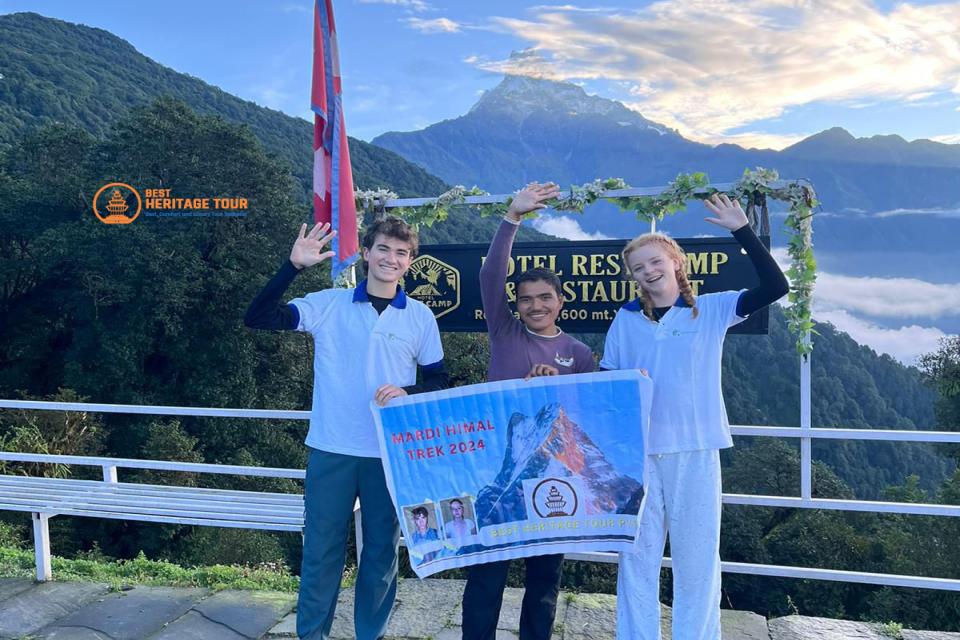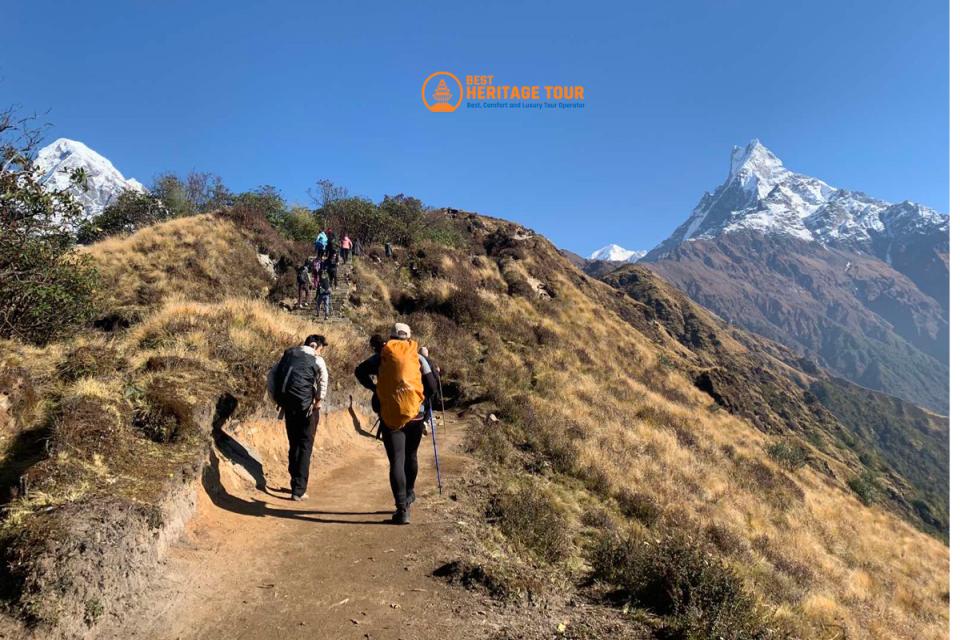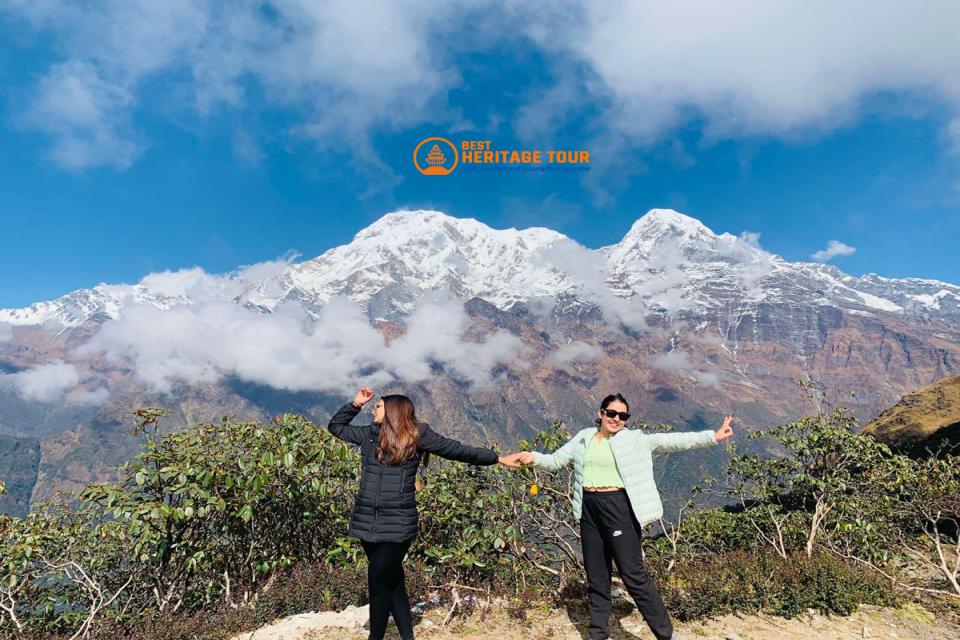Nestled in the heart of Nepal’s Annapurna region, the Mardi Himal Trek is one of the most scenic and less-crowded trekking routes in the Himalayas. From dense rhododendron forests and quaint Gurung villages to the dramatic peaks of Annapurna South, Hiunchuli, and Machhapuchhre (Fishtail), this trek offers an intimate Himalayan experience for those seeking both adventure and serenity.
March is an ideal month for trekking Mardi Himal. As spring begins, the trail is adorned with blossoming rhododendrons, the skies are typically clear, and the mountain panoramas are at their peak glory. For trekkers, travellers, and nature enthusiasts planning their journey, this guide by Best Heritage Tour covers everything you need to know about the Mardi Himal Trek in March - including weather, route, permits, accommodation, packing tips, acclimatisation, and expert trekking advice.
Why Choose Mardi Himal Trek in March?
The Mardi Himal Trek is increasingly popular among trekkers who prefer less crowded trails with stunning views of the Annapurna range. March offers unique advantages for this journey:
-
Optimal Weather: March marks the start of spring in Nepal. Temperatures are moderate and comfortable for trekking, with generally clear skies.
-
Rhododendron Blooms: The forests of the lower and mid-hills are vibrant with red, pink, and white rhododendron flowers.
-
Perfect Mountain Views: Visibility is usually excellent, offering breathtaking views of Machhapuchhre (Fishtail), Annapurna South, Hiunchuli, and other peaks.
-
Moderate Trail Traffic: While March sees more trekkers than winter, Mardi Himal is still less crowded than Annapurna Base Camp or Everest Base Camp trails, allowing a peaceful trekking experience.
-
Cultural Experience: The trail passes through Gurung villages, offering insights into local culture, customs, and traditional architecture.
Mardi Himal Trek Overview
-
Starting Point: Kande (1,370m) / Pokhara (drive to trailhead)
-
Ending Point: Kande / Pokhara (loop trek)
-
Highest Point: Mardi Himal Base Camp (4,500m)
-
Trek Duration: 5-7 days (standard)
-
Difficulty Level: Moderate
-
Accommodation: Teahouses / lodges
-
Best Month: March
-
Permits Required: Annapurna Conservation Area Permit (ACAP) & Trekkers’ Information Management System (TIMS) Card
Weather and Temperature in March
March is a transitional month in Nepal, moving from the winter cold into spring warmth. For Mardi Himal, this is one of the best months to trek.
Temperature Overview:
-
Pokhara (850m): 12°C - 25°C
-
Pothana (2,100m): 5°C - 18°C
-
Low Camp (2,900m): -2°C - 12°C
-
High Camp (3,700m): -5°C - 8°C
-
Mardi Himal Base Camp (4,500m): -10°C - 5°C
The weather in March is mostly dry, with occasional light pre-monsoon showers later in the month. Days are bright and sunny, while mornings and evenings at higher altitudes are chilly.
How to Reach Mardi Himal Trek
The Mardi Himal Trek is accessible via Pokhara, Nepal’s adventure hub. Most trekker’s first fly or drive into Pokhara from Kathmandu:
-
Option 1: Flight from Kathmandu to Pokhara (25 minutes)
-
Option 2: Drive from Kathmandu to Pokhara (6-7 hours, scenic)
From Pokhara, you drive to Kande or Siddha trailheads, where the trek begins. The route forms a loop returning to Pokhara, making logistics convenient and scenic.
Typical Mardi Himal Trek Itinerary (6 Days)
-
Day 1: Drive Pokhara to Dhampus, Trek to Deurali
-
Day 2: Trek to Forest Camp (2,550m), passing through rhododendron forests and waterfalls
-
Day 3: Trek to High Camp (3,700m), enjoying panoramic views of Machhapuchhre and Annapurna South
-
Day 4: Trek to Mardi Himal Base Camp (4,500m), return to Low Camp
-
Day 5: Trek to Jhinu Danda, capturing views along the way
-
Day 6: Trek back to Ghandruk Phedi and drive to Pokhara
This itinerary provides a comfortable trekking pace, allowing proper acclimatization while maximizing sightseeing opportunities.
Permits Required for Mardi Himal Trek
To trek Mardi Himal, you need two permits:
-
Annapurna Conservation Area Permit (ACAP):
-
Cost: NPR 3,000 per person (approx. USD 25)
-
Obtainable in Pokhara or Kathmandu
-
-
Trekkers’ Information Management System (TIMS) Card:
-
Cost: NPR 2,000 per person (approx. USD 15-20)
-
Issued through trekking agencies or in Pokhara
-
Professional trekking companies like Best Heritage Tour will arrange permits in advance, so trekkers can start their journey hassle-free.
Difficulty Level and Preparation
The Mardi Himal Trek is moderate in difficulty. The trek involves steep ascents, descending trails, and uneven paths through forested and alpine terrain. It is suitable for trekkers with moderate fitness levels, including first-time trekkers with proper preparation.
Preparation Tips:
-
Train 6-8 weeks before the trek. Include hiking, stair climbing, running, or cycling.
-
Focus on leg strength, core stability, and endurance.
-
Practice walking long distances with a loaded backpack to simulate trekking conditions.
-
Mental preparation is important - some sections can be steep and demanding.
Altitude and Acclimatization
The Mardi Himal Base Camp sits at 4,500m, which is high enough for mild to moderate altitude sickness to occur. Proper acclimatization and hydration are essential.
Tips to Avoid Altitude Sickness:
-
Ascend gradually and follow the suggested itinerary
-
Drink 3-4 liters of water daily
-
Avoid alcohol and heavy meals at high altitude
-
Spend extra time at Forest Camp or Low Camp for acclimatization
-
Consider medications like Diamox, after consulting your doctor
Following these precautions will make your trek safe and enjoyable.
Accommodation and Meals
The Mardi Himal trail offers teahouse trekking, which provides both comfort and cultural immersion.
Accommodation:
-
Twin-sharing rooms with basic bedding are common
-
Bathrooms may be shared, with hot showers available for a small fee
-
Bring a warm sleeping bag for higher camps
Meals:
-
Local staples: Dal Bhat (rice and lentils), noodles, momo, and soups
-
Breakfast options: porridge, eggs, pancakes, or bread
-
Vegetarian meals are widely available and easy to digest
-
Hot drinks like tea and coffee are ideal for high-altitude energy
Packing List for Mardi Himal Trek in March
March weather requires a combination of warm layers for high camps and lighter clothing for lower altitudes.
Clothing:
-
Moisture-wicking T-shirts
-
Trekking trousers and thermal leggings
-
Fleece or soft-shell jacket
-
Down jacket for higher camps
-
Waterproof and windproof jacket
-
Hat, gloves, and neck scarf or buff
-
Trekking socks (4-5 pairs)
Footwear:
-
Broken-in trekking boots
-
Sandals or trainers for evenings
Gear:
-
Trekking poles
-
Daypack (30-40L)
-
Duffel bag for porters
-
Refillable water bottles or hydration bladder
-
Headlamp with extra batteries
-
Power bank
Other Essentials:
-
Sunscreen and lip balm
-
First aid kit
-
Water purification tablets
-
Personal documents (passport, permits)
Flora, Fauna, and Himalayan Culture
Flora:
March is prime season for rhododendrons and wildflowers. Forests of oak, maple, and pine cover the trail’s lower sections.
Fauna:
-
Birds: Himalayan monal (national bird), pheasants, woodpeckers
-
Mammals: Himalayan langur, musk deer, Himalayan field mice
Culture:
-
Trek passes through Gurung and Magar villages
-
Local monasteries and prayer flags provide cultural insight
-
Traditional village houses showcase Nepalese Himalayan architecture
Highlights of Mardi Himal Trek
-
Breathtaking views of Machhapuchhre (Fishtail), Annapurna South, Hiunchuli
-
Solitude and fewer crowds compared to Annapurna Base Camp
-
Walking through pristine rhododendron forests
-
Experiencing authentic Gurung village life
-
Spectacular sunrise and sunset over Himalayan peaks
-
Panorama from Mardi Himal Base Camp at 4,500m
Connectivity, Electricity, and Internet
-
Electricity: Available in teahouses at Forest Camp and higher camps (small fee for charging)
-
Wi-Fi: Limited, mostly in Pokhara; high-altitude lodges rarely have connectivity
-
Mobile Network: Ncell and NTC have intermittent signals along lower and mid-trail areas
Booking Your Mardi Himal Trek in March
March is a popular trekking month due to ideal weather and scenery. Early booking ensures:
-
Reserved accommodation along the trail
-
Confirmed flights or transportation to Pokhara
-
Permit arrangements handled in advance
-
Professional guides and support staff
Booking with Best Heritage Tour guarantees a safe, organized, and culturally immersive trekking experience.
Practical Tips for Mardi Himal Trek in March
-
Start trekking early each morning to enjoy clear mountain views
-
Keep cash for tea houses; ATMs are only in Pokhara
-
Drink plenty of water and eat small meals frequently
-
Carry a lightweight rain jacket for sudden showers
-
Follow your guide’s advice regarding pace and acclimatization
Conclusion - Your Adventure Awaits
The Mardi Himal Trek in March is an ideal Himalayan adventure - offering stunning landscapes, rich culture, and a less crowded trekking experience. From rhododendron forests to high mountain panoramas, every step promises discovery, challenge, and unforgettable memories.
Start planning your Mardi Himal journey today with Best Heritage Tour, your trusted partner in Nepal trekking.
Contact Best Heritage Tour
Phone / WhatsApp / Viber: +977-9851149197 / +977-9810043046
Email: info@bestheritagetour.com / bestheritagetour@gmail.com
Website: www.bestheritagetour.com
Office: Thamel Marg, Kathmandu, Nepal
Author: Best Heritage Tour
Date: 10th November, 2025




